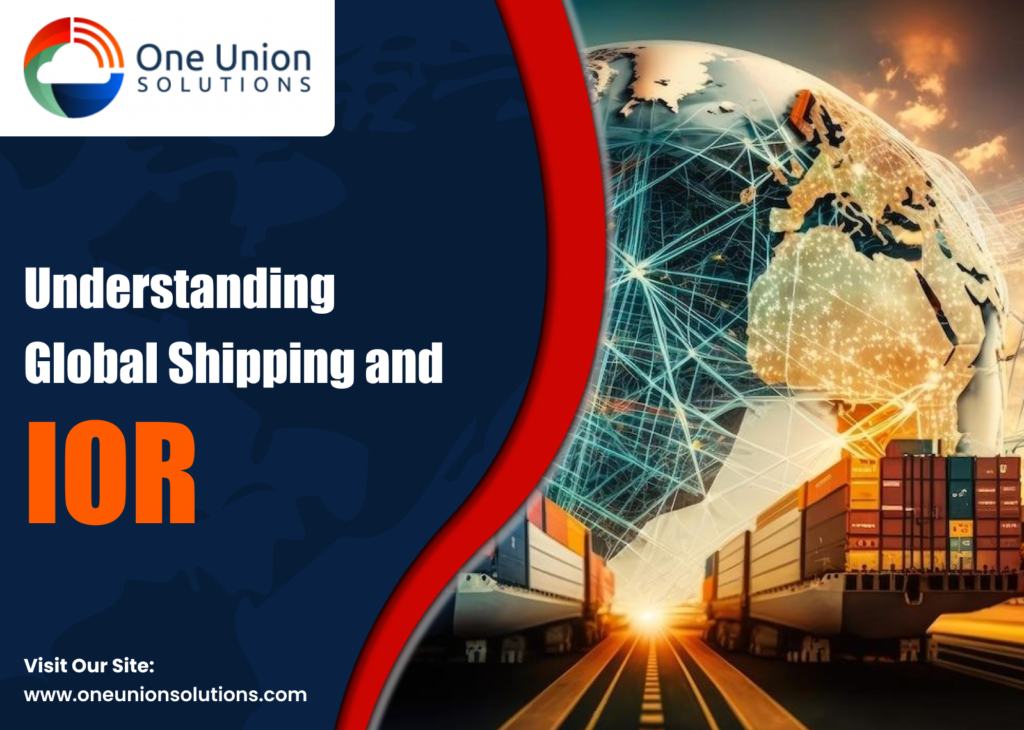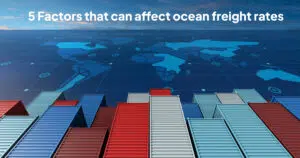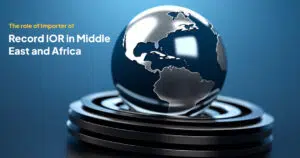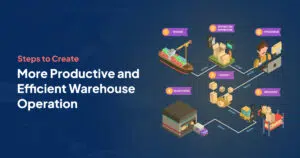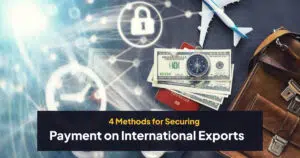There is a need for IOR to comprehend the movement of products in all their stages and functions such as trade, shipping transport, etc.; and IOR here plays a large role. Each of these elements is the skeleton in global trade, enabling goods movement across international boundaries and not forgetting compliance by various regimens.
Worldwide Shipping and IOR.
Global shipment is a broad subject encompassing various entities, for instance, the transporters and facilitators include Shippers carriage providers as well as authority governing regulation. It serves as the lifeline of global trade allowing goods to transit from producers to traders internationally.
The role of the IOR is central here. The IOR is an importer’s agent, the one concerned with guaranteeing that all imported goods meet locally established standards and requirements. They cater to legal and compliance on cargo imports into any country. This comprises getting the required permits and licenses, filling out all appropriate documents as well as liaison with customs agents. The IOR also handles tax and duty paying off for goods importation.
Global Shipping and IOR in International Trade
Global shipping and the role of the IOR are significant in international trade for several reasons:
Expansion of Markets: Thus, international trade enables the nations to be able to increase their markets and get hold of products or services that, if otherwise, would have been home-based due to one reason invalid here. This leads to a sense of competition in pricing and makes the consumer have access at home cheaper.
Compliance with Regulations: The IOR guarantees that all imported goods meet the local regulations and standards. Refusal to adhere to these rules attracts massive fines and penalties, maybe goods are confiscated or destroyed in the worst cases.
Management of Taxes and Duties: The IOR is tasked with handling tax and duty considerations that come about as a result of importing traded goods. Complicated payment schedules and calculations can be handled by an IOR adeptly, saving time as well.
Economic Growth: Globalization can be attributed to international trading6. It has lead to super ratio growth in international trade. The growth of trade over the past century has simply been spectacular; in other words, the actual exportation value worldwide today is nearly 25%.
IOR’s Role in Global Supply Chain Management.
Supply chain management (SCM) is a broad process that manages the movement of goods and services from point of origin to consumption. It encompasses many stages, including the process of finding primary materials; transforming these into products and finally delivering such finished goods to consumers.
The Importer of Record (IOR) is a very crucial aspect, especially in terms of goods importation. The IOR is mandated to ensure that all obligations concerning the importation of goods are met. This involves duties like filing the necessary documents to customs, paying taxes, and ensuring that imported goods meet local standards.
In international trade, an IOR is an individual or organization that has a legal liability to ensure compliance with all state, local, and federal laws governing the importation of goods. This role is very essential in reducing risks and increasing efficiency in international supply chains
The role of IOR in the supply chain integration
Supply chain integration is a strategic process that encompasses the interlinking of production stages within supply chains. This could be in the form of merging suppliers, customers, and all other stakeholders involved with the manufacture and delivery of goods & services.
The IOR is an integral part of supply chain integration. Through compliance with all regulations relevant to its operations and management of taxes as well as duties that are paid for goods imports, IOR ensures efficiency and effectiveness in the supply chain.
Additionally, the IOR like One Union Solutions can simplify processes, eliminate mistakes, and enhance compliance by instilling structured document management practices; leveraging technology to automate key functions; and centralizing import-related information. This finally improves supply chain effectiveness.
In addition, the IOR is a significant feature in risk mitigation and supply chain visibility. By leveraging technology solutions such as track and trace systems, real-time visibility platforms, and data analytics among other tools IORs can gain insights into the movement of goods to detect possible bottlenecks. This allows one to act fast such as redirecting shipments, adjusting inventory levels, or involving suppliers in solving problems.
IOR Logistics: A General Review
Logistics, in the case of an IOR, implies planning and implementation of detailed operations that are related to importation. This process is complex and involves several tasks:
Obtaining necessary permits and licenses: It is the duty of IOR to get all licenses and permits that are needed for importation. It may involve import licenses, health and safety certificates as well as other permits depending on the nature of goods being imported.
Filing necessary paperwork with customs authorities: The IOR is required to fill and submit all the documents needed by customs authorities. This also involves customs declarations, invoices, and packing lists among other documents that describe the shipment of goods.
Handling tax and duty payments: Importing goods usually leads to the payment of taxes and duties. The IOR must compute and pay such amounts. This presupposes a deep knowledge of the country’s tax laws and tariff schedules.
Ensuring compliance with local regulations: The IOR needs to make sure that every imported good meets the local standards and regulations. This may include the testing and certification, labeling & packaging regulations besides other laws depending on goods.
Shipping Logistics
Shipping logistics is an essential aspect of any supply chain. It encompasses all the operations that are required to transport finished goods from their point of production to the end user. Key aspects of shipping logistics include: It is through this provision that the explanation provided by the author makes sense in relation to how she interprets her dream.
Carrier alliances: These are alliances between two or more shipping companies for the provision of joint services to clients. They can assist in increasing the services provided by individual carriers and also improve the efficiency of shipping activities.
Freight shipping: This is the shipping of commodities in bulk. It can be done by different means of transportation such as sea, air, rail, and road.
First-mile and last-mile delivery: The first-mile delivery is the transportation of goods from a retailer to a courier service or as directly as possible. The last mile delivery is the final step of a product being delivered to an end-user customer.
IOR Shipping Process
The IOR shipping process involves several steps that ensure the smooth importation of goods:
Checking shipment details: The IOR verifies the details of the shipment to ascertain that all information is correct and comprehensive.
Completing customs paperwork: IOR makes the relevant paperwork for customs, which describes goods being imported.
Procuring import permits: Where necessary, the IOR procures import permits as required. This may include submitting an application to the appropriate government agencies and enclosing necessary documents.
Paying import duties: The IOR computes and pays the corresponding import duties. This calls for knowledge of the country’s tariff schedules.
Coordinating with customs officials: The IOR liaises with customs officials to ensure that the cargo is cleared for importation in time.
Import Logistics
Import logistics services allow companies to control their global supply chain. These services can include:
Setting up processes such as transloading: Transloading is the process of transferring goods from one mode to another. This can also be used to streamline the supply chain and lower costs.
Taking care of finer details: This may include paperwork, liaison with suppliers and transport providers as well as administration of inventory.
Tracking inventory and shipping processes: Systems for managing inventory and tracking shipments are common in import logistics services. This can also aid companies to handle their supply chain better.
Future Trends: Global Shipping and IOR’s Changing Role.
The Importer of Record (IOR) role is changing as the global shipping industry goes through a transformation. Here are some key trends that are shaping the future of global shipping and the role of IOR: The situation was further complicated by the fact that most of them had a negative attitude towards work.
Digitalization: Digital adoption is becoming even more popular in the shipping and logistics industry. Major players in shipping and boutique companies have developed their own software systems as well. Advancements in AI and blockchain technology are likely to continue the digitalization of world shipping, automating it even more. This will enhance real-time shipment tracking and supply chain visibility.
Economic Headwinds: With a bumpy post-pandemic economic period and the aftershocks of COVID-19, businesses are hoping that hard times have passed. There are a great number of positive points in the economy to feel confident with, including increasing wages; some steps towards reducing the income gap; fewer regulations, and decreasing inflation.
Climate Change and Geopolitical Tensions: These may impact the availability of resources, create transportation bottlenecks, disrupt manufacturing operations, and increase costs. Besides, international conflicts and tensions as well as existing ones that have yet to emerge may influence supply chain activities and investments.
Consolidation: The freight forwarding market for mergers and acquisitions has grown in the wake of COVID-19, with no signs that it will slow down by 2024. The Loadstar, on the back of a series of acquisitions in this sector, projected that 2017 will be ‘a year of consolidation.
Capacity and Demand Volatility: A challenging combination of weak freight demand and rising capacity to face the transport and logistics sector. BIMCO, the international shipping association estimates that global container volumes will grow by only 3-4% in 2024 while at the same time with a record high ship fleet reaching up to almost three million TEU.
These trends are likely to impact the function of IOR, as they will be required to adjust accordingly and maintain compliance with emerging regulations and standards.

